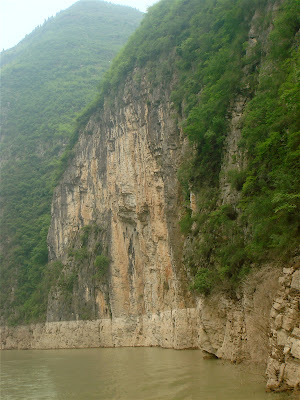
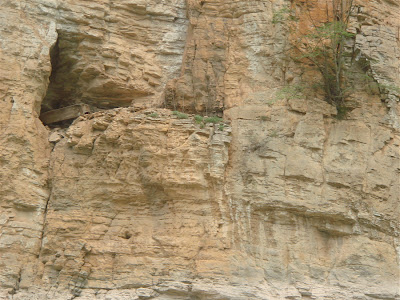
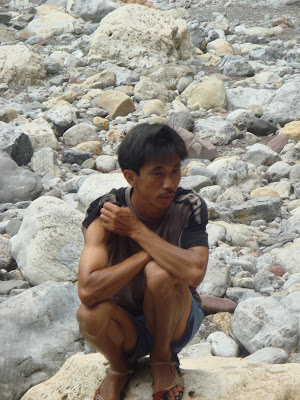

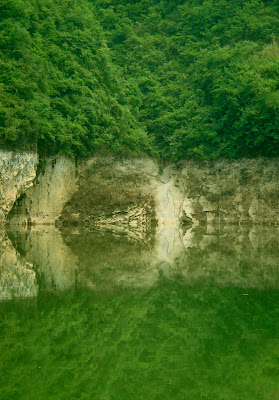
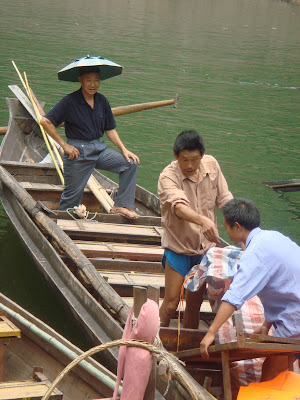

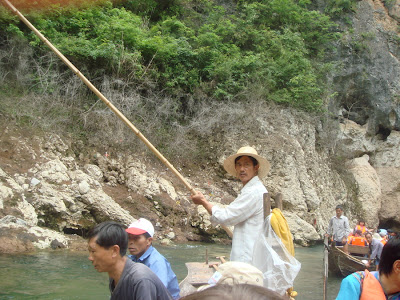
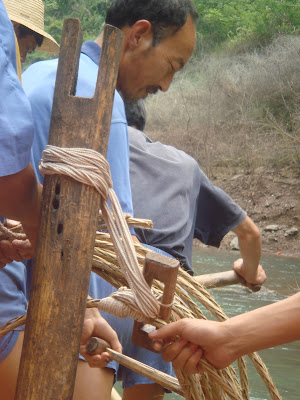
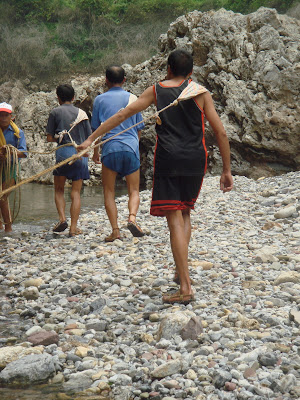
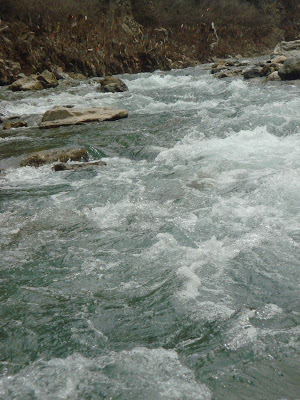
One of the side trips we took while traveling along the Yangtze River was to a place called Shennong Stream. No one on the tour really had any idea what to expect when we got there. A sampan ride through a minor gorge was all that we had been told.
So, after breakfast we disembarked from our cruise ship, clambered onto a ferry and headed down a rather large stream at the mouth of the Wu Gorge and away from the Yangtze River. Though the water voyage so far had been quiet and peaceful we now entered another level of silence. The limestone cliffs shot up higher and hugged the shore more closely than they had until this time. What had along the larger river been soft, almost furry hills filled with indigenous trees and underbrush, now we were surrounded by craggy mountains, large fields of bamboo and deep thick brush that looked sharp and unfriendly.
We traveled in the ferry for almost an hour with our guide indicating various points of interest. On one shore the water stood so still and clear that the rugged outcrop of rocks on the shoreline and the reflection in the river made a perfectly delightful Rorschach image.
The guide talked about seeing monkeys sometimes or other wild animals like goats, and sheep, but we only saw a few birds. Then in the middle of what appeared to be nowhere, we came to a shack moored on a riverbank. We glided up to the place and we stepped out onto the rickety dock. We were herded through the main building that turned out to be a tourist attraction gift shop and then out through the back door where 20 or 30 sampans sat waiting for us to climb on board.
We had arrived in a place called Dadong and the men waiting in the sampans were farmers who had been displaced by the rising water of the Three Gorges Dam. They are now called ‘boat trackers’ and take tourists on rides up the Shennong Stream. They are thin small men with very strong back and leg muscles.
Once everyone had settled into a sampan and life jackets were securely fastened, we set off up stream. The water was quieter now. Even quieter than when we’d been on the ferry. We were sitting much closer to the water now, too, and those of us in the outside seats could dangle our hands in the water, a very refreshing experience on such a hot and steamy day.
The banks of this river has been inhabited since at least the Han Dynasty and the primary ethnic group of this river valley has been the Thuja people. Since the beginning of the construction of the Three Gorges Dam, the water level has risen approximately 155 meters at the mouth of the Shennong Stream. Much of the previously scenic vertical gorge is now evidently submerged. By the completion of the dam construction in 2009, a further 20 meters of the gorge will be under water.
The boat trackers guided us up the stream using very simple boat riggings and poles. The water sounded and felt like real water, gurgling, splashing and at times was so clear that I could count the pebbles passing under the sampan. And then we arrived at a small rapid. All the boat trackers at that point jumped into the water, except for the man in charge of the rudder. Each man threw a harness like contraption over his shoulder and they began to pull the sampan through the quickly moving water. It was all a bit thrilling but not dangerous.
They pulled us along through the water until it was clear that the water was too shallow for a boat to go any further. At that point we were told it was time to eat our lunches and though we were told that we could not get out of the boats we were treated to gifts of pebbles that the men gathered from the water. Most of us shared our lunches with the boat trackers and we sat in the middle of this strange stream, this very ancient place in China eating boiled eggs and fresh fruit.
I couldn’t help but notice the shoes that the boat trackers wore. The simple woven bottoms of the soles with a simple jute cord wrapped around one side and then tied was all that they seemed to need to walk in the water and over the river rocks and large boulders. They were smart looking sandals that any shoe designer of today would love to have invented.
Then when the time was up the boatmen grabbed up their harnesses again and pulled us back into the deeper water where we were treated to a boat race back to the home base. This ride is now an industry on the Shennong Stream. The farmers displaced from their land have moved into another line of work and as we headed back to our tour boat on the ferry we saw many more boat trackers leaving the stream, the days work finished, the life vests piled in the middle of the sampan.
The excursions up the Shennong Stream have brought other employment opportunities to this community. There are boats at every turn on the stream with men and sometimes women gathering up the debris that floats along the river. Twigs and garbage floats along the shoreline and seems to be quickly scooped up by these keepers of the water. It is easy to see how high the water has sometimes risen from the plastic bags and cloth that hang high in the trees like flapping Tibetan prayer flags.
Half way back to the tour boat our guide pointed out a location along the river where high up in the cliffs we could see ‘hanging coffins’. These coffins that are stowed in caves and crevices on the high vertical limestone cliffs are evidence of the early history of settlements in the Shennong Gorge. It’s still not known how these heavy coffins were actually secured on such steep, and inaccessible places. The coffins were typically carved from a single section of a tree trunk, with some coffins measuring approximately 90 centimeters in diameter. The coffins are typically 30 to 150 meters from the top of the bluff and 25 to 70 meters above the river surface. Most commonly a coffin rests on two sturdy hewn poles that have been wedged within the limestone cleft or cave to form a level platform for the coffin to rest.
The Three Gorges Dam construction has destroyed many of these coffins, though some are being retrieved for cultural presentation and archeological study. One such coffin has been preserved and now sits on display at the White Emperor’s Palace, within an historical Daoist Temple situated high above the inundated level along the Yangtze River.
I have gathered some of the technical information about this area from the inter net, but I was there, watching, smelling, touching and experiencing everything that I could. I hope that these pictures give you an idea of what it was like to travel on the Shennong Stream.

1 comment for “SHENNONG STREAM”